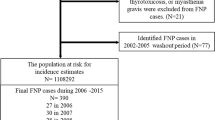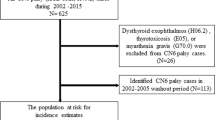Abstract
Background
Neurologically isolated ocular motor nerve palsies often present a management dilemma. Neuroimaging is more likely to be offered to patients <50 years without coexisting ischaemic risk factors as their risk of sinister underlying causes is thought to be higher. However, populations are rapidly ageing and advanced neuroimaging is now more widely available. We thus investigated the incidence of abnormal neuroimaging outcomes in the traditionally low-risk older patient group.
Methods
This is a retrospective cohort study of 353 patients presenting with isolated ocular motor nerve palsies to a tertiary neuro-ophthalmology service in Singapore over a four-year (2015 to 2019) period. Clinical data was obtained through manual review of case records. Common aetiologies, age-based differences in prevalence of causes and abnormal neuroimaging outcomes were statistically analysed.
Results
Abnormal neuroimaging outcomes were significantly greater in the younger cohort only when age segregation was performed at 60 years of age. In a multivariate analysis, acute onset rather than ischaemic risk factors were independently predictive of normal neuroimaging outcomes. After adjusting for prior cancer risk and clinical bias from presumed ischaemic palsies, abnormal neuroimaging outcomes were seen in 14.1% ≥ 50 yrs, 10.9% ≥ 60 yrs and 15.1% ≥ 70 yrs.
Conclusions
In patients presenting with isolated ocular motor nerve palsies, acute onset may be a more reliable indicator of an ischaemic palsy rather than advanced age or presence of ischaemic risk factors. If onset is not acute, neuroimaging should be considered irrespective of age and coexisting ischaemic risk factors.
This is a preview of subscription content, access via your institution
Access options
Subscribe to this journal
Receive 18 print issues and online access
$259.00 per year
only $14.39 per issue
Buy this article
- Purchase on Springer Link
- Instant access to full article PDF
Prices may be subject to local taxes which are calculated during checkout



Similar content being viewed by others
Data availability
The data that support the findings of this study are available on request from the corresponding author. The data are not publicly available due to privacy or ethical restrictions.
References
Pineles SL, Velez FG. Isolated ocular motor nerve palsies. J Binocul Vis Ocul Motil [Internet]. 2018;68:70–7.
Galtrey CM, Schon F, Nitkunan A. Microvascular non-arteritic ocular motor nerve palsies - what we know and how should we treat? Neuro-Ophthalmology. 2015;39:1–11.
Tamhankar MA, Biousse V, Ying GS, Prasad S, Subramanian PS, Lee MS, et al. Isolated third, fourth, and sixth cranial nerve palsies from presumed microvascular versus other causes: a prospective study. Ophthalmology. 2013;120:2264–9.
Chou KL, Galetta SL, Liu GT, Volpe NJ, Bennett JL, Asbury AK, et al. Acute ocular motor mononeuropathies: prospective study of the roles of neuroimaging and clinical assessment. J Neurol Sci. 2004;219:35–9.
Murchison AP, Gilbert ME, Savino PJ. Neuroimaging and acute ocular motor mononeuropathies: a prospective study. Arch Ophthalmol. 2011;129:301–5.
Park KA, Oh SY, Min JH, Kim BJ, Kim Y. Cause of acquired onset of diplopia due to isolated third, fourth, and sixth cranial nerve palsies in patients aged 20 to 50 years in Korea: a high resolution magnetic resonance imaging study. J Neurol Sci [Internet]. 2019;407:116546.
Akagi T, Miyamoto K, Kashii S, Yoshimura N. Cause and prognosis of neurologically isolated third, fourth, or sixth cranial nerve dysfunction in cases of oculomotor palsy. Jpn J Ophthalmol. 2008;52:32–5.
Richards BW, Jones FR, Younge BR. Causes and prognosis in 4,278 cases of paralysis of the oculomotor, trochlear, and abducens cranial nerves. Am J Ophthalmol. 1992;113:489–96.
Volpe NJ, Lee AG. Do patients with neurologically isolated ocular motor cranial nerve palsies require prompt neuroimaging? J Neuro-Ophthalmology. 2014;34:301–5.
Keane JR. Fourth nerve palsy: Historical review and study of 215 inpatients. Neurology. 1993;43:2439-43.
Margolin E, Lam CTY. Approach to a patient with diplopia in the emergency department. J Emerg Med [Internet]. 2018;54:799–806.
Development Core Team R. R: a language and environment for statistical computing. R Foundation for Statistical Computing Vienna Austria. 2011.
Kung N, Van Stavern G. Isolated ocular motor nerve palsies. Semin Neurol. 2015; 35:539–48.
Author information
Authors and Affiliations
Contributions
SYC analysed the data and wrote the manuscript together with SS. JX collected the data. ST, DM, JL and SS conceptualised and helped to supervise the project with SS primarily supervising. All authors discussed the results and contributed to the final manuscript. We thank and acknowledge Prof Umapathi N Thirugnanam for critical comments on the manuscript.
Corresponding author
Ethics declarations
Competing interests
The authors declare no competing interests.
Additional information
Publisher’s note Springer Nature remains neutral with regard to jurisdictional claims in published maps and institutional affiliations.
Supplementary information
Rights and permissions
Springer Nature or its licensor (e.g. a society or other partner) holds exclusive rights to this article under a publishing agreement with the author(s) or other rightsholder(s); author self-archiving of the accepted manuscript version of this article is solely governed by the terms of such publishing agreement and applicable law.
About this article
Cite this article
Chan, SY.C., Hsu, J.CL., Tow, S.L.C. et al. Are isolated ocular motor nerve palsies in the elderly truly ‘low risk’ for abnormal neuro-imaging outcomes?. Eye 38, 773–777 (2024). https://doi.org/10.1038/s41433-023-02775-7
Received:
Revised:
Accepted:
Published:
Issue Date:
DOI: https://doi.org/10.1038/s41433-023-02775-7



